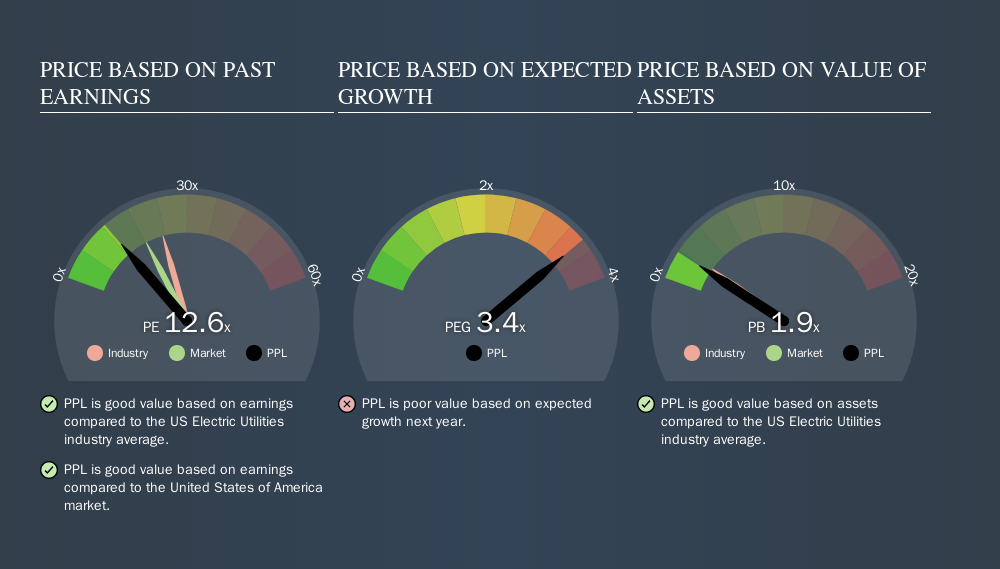- United States
- /
- Electric Utilities
- /
- NYSE:PPL
Do You Know What PPL Corporation's (NYSE:PPL) P/E Ratio Means?

Today, we'll introduce the concept of the P/E ratio for those who are learning about investing. To keep it practical, we'll show how PPL Corporation's (NYSE:PPL) P/E ratio could help you assess the value on offer. Looking at earnings over the last twelve months, PPL has a P/E ratio of 12.64. In other words, at today's prices, investors are paying $12.64 for every $1 in prior year profit.
View our latest analysis for PPL
How Do You Calculate PPL's P/E Ratio?
The formula for P/E is:
Price to Earnings Ratio = Share Price ÷ Earnings per Share (EPS)
Or for PPL:
P/E of 12.64 = $31.13 ÷ $2.46 (Based on the trailing twelve months to June 2019.)
Is A High Price-to-Earnings Ratio Good?
The higher the P/E ratio, the higher the price tag of a business, relative to its trailing earnings. That isn't necessarily good or bad, but a high P/E implies relatively high expectations of what a company can achieve in the future.
Does PPL Have A Relatively High Or Low P/E For Its Industry?
One good way to get a quick read on what market participants expect of a company is to look at its P/E ratio. The image below shows that PPL has a lower P/E than the average (23.3) P/E for companies in the electric utilities industry.

PPL's P/E tells us that market participants think it will not fare as well as its peers in the same industry. While current expectations are low, the stock could be undervalued if the situation is better than the market assumes. If you consider the stock interesting, further research is recommended. For example, I often monitor director buying and selling.
How Growth Rates Impact P/E Ratios
When earnings fall, the 'E' decreases, over time. That means unless the share price falls, the P/E will increase in a few years. Then, a higher P/E might scare off shareholders, pushing the share price down.
It's great to see that PPL grew EPS by 22% in the last year. And its annual EPS growth rate over 5 years is 11%. With that performance, you might expect an above average P/E ratio. In contrast, EPS has decreased by 2.0%, annually, over 3 years.
Remember: P/E Ratios Don't Consider The Balance Sheet
One drawback of using a P/E ratio is that it considers market capitalization, but not the balance sheet. Thus, the metric does not reflect cash or debt held by the company. The exact same company would hypothetically deserve a higher P/E ratio if it had a strong balance sheet, than if it had a weak one with lots of debt, because a cashed up company can spend on growth.
Such expenditure might be good or bad, in the long term, but the point here is that the balance sheet is not reflected by this ratio.
How Does PPL's Debt Impact Its P/E Ratio?
Net debt totals 100% of PPL's market cap. This is enough debt that you'd have to make some adjustments before using the P/E ratio to compare it to a company with net cash.
The Bottom Line On PPL's P/E Ratio
PPL's P/E is 12.6 which is below average (18.2) in the US market. While the EPS growth last year was strong, the significant debt levels reduce the number of options available to management. The low P/E ratio suggests current market expectations are muted, implying these levels of growth will not continue.
When the market is wrong about a stock, it gives savvy investors an opportunity. As value investor Benjamin Graham famously said, 'In the short run, the market is a voting machine but in the long run, it is a weighing machine.' So this free visualization of the analyst consensus on future earnings could help you make the right decision about whether to buy, sell, or hold.
You might be able to find a better buy than PPL. If you want a selection of possible winners, check out this free list of interesting companies that trade on a P/E below 20 (but have proven they can grow earnings).
We aim to bring you long-term focused research analysis driven by fundamental data. Note that our analysis may not factor in the latest price-sensitive company announcements or qualitative material.
If you spot an error that warrants correction, please contact the editor at editorial-team@simplywallst.com. This article by Simply Wall St is general in nature. It does not constitute a recommendation to buy or sell any stock, and does not take account of your objectives, or your financial situation. Simply Wall St has no position in the stocks mentioned. Thank you for reading.
About NYSE:PPL
PPL
Provides electricity and natural gas to approximately 3.5 million customers in the United States.
Solid track record unattractive dividend payer.
Similar Companies
Market Insights
Community Narratives



